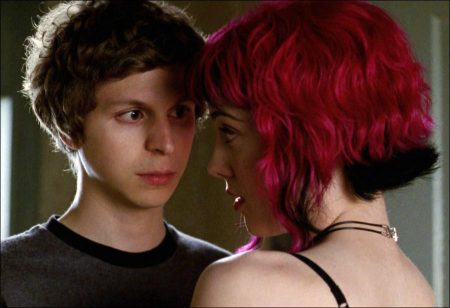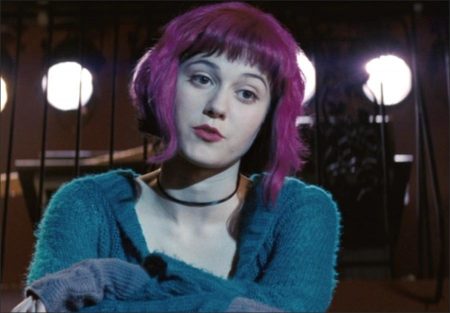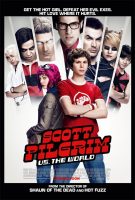Taglines: An epic of epic epicness.
Meet charming and jobless Scott Pilgrim (Michael Cera). A bass guitarist for garage band Sex Bob-omb, the 22-year-old has just met the girl of his dreams…literally. The only catch to winning Ramona Flowers (Mary Elizabeth Winstead)? Her seven evil exes are coming to kill him. Genre-smashing filmmaker Edgar Wright (“Hot Fuzz,” “Shaun of the Dead”) tells the amazing story of one romantic slacker’s quest to power up with love in “Scott Pilgrim vs. the World.”
Scott Pilgrim has never had a problem getting a girlfriend. It’s getting rid of them that proves difficult. From the girl who kicked his heart’s ass–and now is back in town–to the teenage distraction he’s trying to shake when Ramona rollerblades into his world, love hasn’t been easy. He soon discovers, however, his new crush has the most unusual baggage of all: a nefarious league of exes controls her love life and will do whatever it takes to eliminate him as a suitor. As Scott gets closer to Ramona, he must face an increasingly vicious rogues’ gallery from her past–from infamous skateboarders to vegan rock stars and fearsomely identical twins. And if he hopes to win his true love, he must vanquish them all before it really is game over.
We’ll get to the notes in a minute. But first, a word from our director / producer/co-writer, EDGAR WRIGHT: “I first heard of Scott Pilgrim in 2004 when BRYAN LEE O’MALLEY’s recently released first volume was pressed into my hands. Given that my previous work has strived to mix up the mundane with the insane, I was hooked immediately. I loved Bryan’s use of manga and video-game iconography to depict the emotions of these young characters.
“Adapting these books was a gift, as they are not only funny, charming and relatable, but have increasingly crazy diversions into the fantastical. To be able to do romance, comedy, action and fantasy in the same feature was an intriguing challenge. “The best way to describe the world of Scott Pilgrim vs. the World is that it’s a normal world of a normal young man, filtered through his overactive imagination. Bryan Lee O’Malley describes Scott as ‘the hero of the movie in his own head.’ My goal is to make that very movie.
“The emotions and interactions throughout the film are infused with the mass media that this generation has grown up with—not just in music, film and animation, but in over 30 years of video games. Our characters’ life experiences are completely governed by the enormous amount of time they’ve spent with their Nintendo consoles. For the twentysomething characters in the film, the incidental music for ‘Zelda’ is as resonant as nursery rhymes.
“In the world of Scott Pilgrim, minor disagreements are resolved in mortal combat. Our hero is thrown into a world of pain when he dates the girl of his dreams. The mysterious Ramona Flowers has something of a hex on her where her seven evil exes challenge her new boyfriend to a series of duels to the death. Many people have jumped through many hoops to pursue someone unobtainable. Scott must literally fight for his new relationship if he wants it to survive.
“The increasingly crazy events of the film are almost the result of wild exaggeration. When teens or twentysomethings describe the events of a night out, they are usually blown out of all proportion. My take on the fights in the film is that they are hugely amplified versions of events. Someone might gossip about the ‘huge fight’ that broke out the night before. And here we see the huge version of that fight.
“The fight sequences in Scott Pilgrim play out like big production numbers. In our film, people break out into fights the same way they explode into a song and dance number in a musical. When the emotion is too great to convey in mere words, characters in a musical will sing out. In Scott Pilgrim, they throw down.
“The film is set in a world of first apartments, crappy bands, thrift stores and coffee shops that we all know and love. It covers young love, loud music and big emotions. We see the world through a cast of young people who have a lot to give and a lot to learn. Oh, and people totally explode into coins.”
About the Production
Producer Marc Platt was introduced to Bryan Lee O’Malley’s graphic novel series when his colleagues Jared LeBoff and Adam Siegel brought O’Malley’s first “Scott Pilgrim” book to his attention in 2004. “I was immediately struck by the buoyancy and vibrancy of the material and how it seemed to capture a moment in time and a generation of characters that were relatable,” Platt recalls. “They’re living in this world that is part comic book, part ninja, part kung fu, part anime, part manga. Yet, at the heart of it are these appealing, accessible kids that you recognize, who have accessible and emotional journeys.”
Platt found the characters in O’Malley’s comics so relatable that he believed they would translate well on film. He notes: “I was moved by the angst of Scott Pilgrim, his romantic yearnings for the girl of his dreams. He has to overcome challenges in order to get where he wants to go.”
Soon after they had seen Edgar Wright’s first feature-length film, Shaun of the Dead, LeBoff and Siegel suggested to Platt that the genre-fusing filmmaker direct the material the team had optioned. Platt acknowledges: “I recognized immediately that the sensibility Edgar would apply to this material was a combustible combination. The moment he said he was interested, the excitement that I had over the source material quadrupled. He works harder than any filmmaker I know, and the work paid off because it’s a complex film where everything has to dovetail into the next piece. Edgar has thought about every piece so it fits perfectly. He is meticulous in his preparation, inspires fun and loves the characters and the material.”
Co-writer/director Wright learned of the property in 2004 when O’Malley’s first book, Oni Press’ “Scott Pilgrim’s Precious Little Life,” was given to him by LeBoff and Siegel at an L.A. preview screening of Shaun of the Dead. “It had only just been released, and these two enterprising fellows said it was perfect material for me,” Wright says. “The book then sat in my bag for at least a month of the Shaun U.S. press tour before I finally read the now-battered copy on a flight. I was thoroughly enjoying it from the first page but then was utterly hooked by the time it came to the scene where Scott Pilgrim receives a written warning of his impending death by e-mail. Even before I’d finished the first volume, I was trying to imagine how it could work as live action.”
Wright was impressed not only by the story, but by the video-game and manga iconography that O’Malley used to underscore the extreme emotions and melodrama the characters experience. He continues: “It actually reminded me of the TV series I did with Simon Pegg and Jessica Hynes called Spaced. I had longed to do something that took the magical realism of that show even further. I was excited to take on the challenge of bringing the books to life and some of the more insane action sequences to the big screen. I’ve always strived in my career to make comedy visually interesting, and this adaptation was the great chance to let my imagination run wild.”
Joining Wright in his latest endeavor would be his longtime producer Nira Park. The head of Big Talk Productions entered into her fourth collaboration with Wright on Scott Pilgrim vs. the World. “Edgar and I have worked together since the television series Spaced. To see the growth he’s achieved from that show to his acclaimed efforts as director of Shaun of the Dead and Hot Fuzz has been astonishing. All of our projects have been labors of love, and Scott is the culmination of that partnership.”
Continue Reading and View the Theatrical Trailer
Scott Pilgrim vs. the World (2010)
Directed by: Edgar Wright
Starring: Michael Cera, Mary Elizabeth Winstead, Alison Pill, Anna Kendrick, Kieran Culkin, Chris Evans, Ellen Wong, Kristina Pesic, Ingrid Haas, Marlee Otto, Aubrey Plaza, Ingrid Haas, Brie Larson
Screenplay by: Michael Bacall, Edgar Wright
Production Design by: Marcus Rowland
Cinematography by: Bill Pope
Film Editing by: Jonathan Amos, Paul Machliss
Costume Design by: Laura Jean Shannon
Set Decoration by: Odetta Stoddard
Art Direction by: Nigel Churcher
Music by: Nigel Godrich
MPAA Rating: PG-13 for stylized violence, sexual content, language and drug references.
Distributed by: Universal Pictures
Release Date: August 13, 2010






